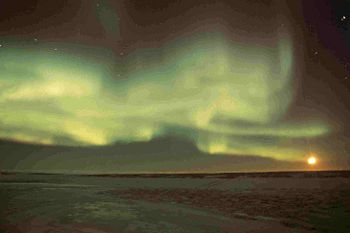Aurora Borealis: Difference between revisions
imported>George Swan (spelling) |
imported>Milton Beychok m (Added a CZ link) |
||
| (4 intermediate revisions by 3 users not shown) | |||
| Line 1: | Line 1: | ||
{{subpages}} | {{subpages}} | ||
{{Image|Aurora borealis,jpg.jpg|right|350px|Aurora Borealis.}} | |||
The '''Aurora Borealis''', also called '''the Northern Lights''', is an | The '''Aurora Borealis''', also called '''the Northern Lights''', is an electromagnetic phenomenon visible near the [[north magnetic pole]].<ref name=SkyGraham> | ||
{{cite news | |||
| url=http://astronomy.swin.edu.au/~agraham/Preprints/sunny/sunny-oz.txt | |||
| title=Solar Outbursts - Storm Warning | |||
| publisher=[[Sky and Telescope]] | |||
| author=Alister Graham | |||
| date=January 2000 | |||
| accessdate=2008-08-26 | |||
| quote=The flow of charged solar particles through the Earth's upper atmosphere is strong enough to ionise atmospheric particles, resulting in the eerie glow in the twilight sky known as the aurora, or the southern and northern lights. Because the interaction of magnetic fields and charged particles is greatest near the Earth's magnetic poles, the auroral phenomenon is more prevalent there than at middle latitudes. | |||
}} | |||
</ref> | |||
Observers describe the Auroras as impressive. [[First Nations]] peoples told tales to interpret their meaning. | Observers describe the Auroras as impressive. [[First Nations]] peoples told tales to interpret their meaning. | ||
[[Planet Earth]] is surrounded by a [[magnetic field]]. The magnetic field captures [[charged particles]] from outer space, and diverts them to the Earth's magnetic poles. | [[Planet Earth]] is surrounded by a [[magnetic field]].<ref name=SkyGraham/> | ||
The magnetic field captures [[charged particles]] from [[outer space]], and diverts them to the Earth's magnetic poles. | |||
When these charged particles interact with the upper atmosphere there are various kinds of exchanges of [[energy]], resulting in the transmission of [[photon]]s of various frequencies -- including [[visible light]]. | When these charged particles interact with the upper atmosphere there are various kinds of exchanges of [[energy]], resulting in the transmission of [[photon]]s of various frequencies -- including [[visible light]]. | ||
| Line 12: | Line 23: | ||
And the intensity of the aurora borealis, and a corresponding [[Aurora Australis]] around the [[south magnetic pole]] is directly related to the intensity of the solar wind. | And the intensity of the aurora borealis, and a corresponding [[Aurora Australis]] around the [[south magnetic pole]] is directly related to the intensity of the solar wind. | ||
When the solar wind is at its most intense it can knock out [[telecommunication satellite]]s. | When the solar wind is at its most intense it can knock out [[telecommunication satellite]]s.<ref name=SkyGraham/> | ||
==References== | |||
<references/> | |||
Revision as of 01:35, 1 September 2009
The Aurora Borealis, also called the Northern Lights, is an electromagnetic phenomenon visible near the north magnetic pole.[1]
Observers describe the Auroras as impressive. First Nations peoples told tales to interpret their meaning.
Planet Earth is surrounded by a magnetic field.[1] The magnetic field captures charged particles from outer space, and diverts them to the Earth's magnetic poles. When these charged particles interact with the upper atmosphere there are various kinds of exchanges of energy, resulting in the transmission of photons of various frequencies -- including visible light.
The source of most of the extraterrestrial charged particles is the solar wind. And the intensity of the aurora borealis, and a corresponding Aurora Australis around the south magnetic pole is directly related to the intensity of the solar wind.
When the solar wind is at its most intense it can knock out telecommunication satellites.[1]
References
- ↑ 1.0 1.1 1.2 Alister Graham. Solar Outbursts - Storm Warning, Sky and Telescope, January 2000. Retrieved on 2008-08-26. “The flow of charged solar particles through the Earth's upper atmosphere is strong enough to ionise atmospheric particles, resulting in the eerie glow in the twilight sky known as the aurora, or the southern and northern lights. Because the interaction of magnetic fields and charged particles is greatest near the Earth's magnetic poles, the auroral phenomenon is more prevalent there than at middle latitudes.”
